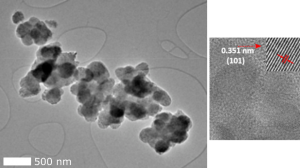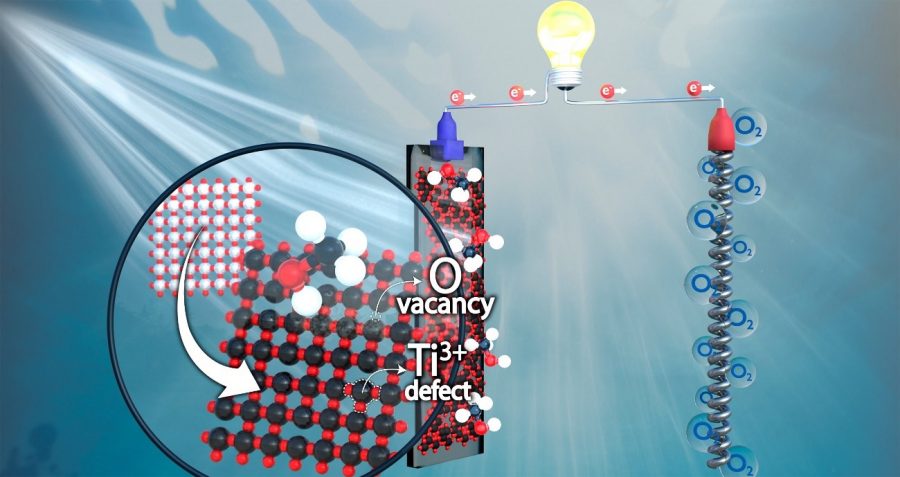
Researchers from the Brazilian Federal University of Mato Grosso do Sul (UFMS) have developed a photosensitive nanomaterial that is very efficient to produce electricity from organic compounds used as fuel and sunlight as the energy source. The process, which is relatively clean and inexpensive, is carried out in a device called a photo fuel cell. In the work, the team used methanol (CH3OH) as fuel, a liquid alcohol that stores a large amount of energy and, when used, generates much less carbon emissions than fossil fuels. The compound has gained attention as a fuel for clean energy generation, mainly because it can be produced from biomass.
“The photo fuel cell developed in our work contains a simple technology capable of converting methanol into energy using only solar energy as an external driving force, operating with simple, stable, abundant materials free of noble metals, which makes the cost of the process considerably low compared to conventional fuel cells”, says Professor Heberton Wender, a corresponding author of the article that reports this advance in the journal ACS Advanced Materials and Interfaces.
Fuel cells are devices that directly convert the chemical energy of a fuel into electrical energy through electrochemical reactions, with low or zero carbon emissions. Used for decades to supply energy in satellites and spacecraft, fuel cells are already present in homes, businesses, industries and electric cars, and are becoming increasingly relevant in the face of the need to generate energy in the cleanest way possible to mitigate climate change. However, the materials needed to efficiently catalyze electrochemical reactions in fuel cell electrodes are generally based on expensive and scarce elements such as noble metals. Therefore, several alternatives are being investigated; among them, the development of fuel photocells.
In these devices, inexpensive photosensitive materials based on abundant elements help drive reactions through the electrons and holes they generate when excited by sunlight. One such material is titanium dioxide (TiO2). This compound, which is usually in the form of a white powder, is not easily degraded by light and is simple to prepare. However, it has an important limitation: it only absorbs ultraviolet radiation, failing to take advantage of other wavelengths that are also present in sunlight, such as the so-called visible light.
In this context, the initial idea was born for the work of the UFMS team, which was developed within Luiz Felipe Plaça’s doctorate under the guidance of Prof. Heberton. “We thought of using self-doped titanium dioxide, that is, with self-induced structural defects, using a simple, inexpensive process that can be easily scaled up in the future”, says the researcher. “That was when we decided to use heat treatment in a reducing atmosphere with small amounts of sodium borohydride (NaBH4)”, he details. The idea generated great results. The treatment made it possible to control the density of defects in the titanium dioxide nanoparticles and, in this way, increase their ability to absorb radiation, including part of the visible spectrum of sunlight. Furthermore, the material lost its characteristic white color and turned black.
The black titanium dioxide was placed on a transparent conductive glass substrate and used as the photoanode of the fuel cell. The photoanode is the component responsible for absorbing sunlight and transforming it into electrons and holes that will reduce oxygen and oxidize fuel, respectively, generating the desired electric current at the end of the process. With the black titanium dioxide photoanodes, the efficiency of the fuel cell showed a very considerable increase in its ability to produce electric current from methanol and solar energy. “The improved device, without the use of noble metals, showed a 2,000% increase in maximum output power”, says Professor Heberton. “This represents an impressive efficiency and puts self-doped titanium dioxide on the list of the most promising materials to be used as photoanodes in photocells fueled by methanol or alternative fuels such as ethanol, glycerol, other alcohols and even organic pollutants with higher molar mass”.

As it can be supplied with organic pollutants – a possibility that was explored in other work by the team, the photocell could be used to decontaminate water without additional energy costs and even generate a little extra electricity for external use in low-power devices. “In a hypothetical scenario, it would be possible to purify water from effluents in rural properties while producing energy”, points out Professor Cauê Alves Martins, who is also a corresponding author of the ACS Applied Materials and Interfaces article.
In addition to the laboratory photocell, the authors prepared, with the new photoanode, a prototype of a small portable device: a microfluidic photo fuel cell. The device, which fits in the palm of a hand, can be produced in less than an hour at a cost of less than $2.00. To develop the prototype, the team had the participation of an undergraduate student in Physics Engineering at UFMS, Pedro Lucas S. Vital, who, guided by Prof. Cauê, accepted the challenge of preparing the cell using a 3D printer. The device was also tested, with good results. Despite being a good prototype, the engineering of the device can yet be improved to increase the power density via scale out, with more devices operating together, comment Heberton and Cauê.
The work is the result of a well-established collaboration between two research groups at the UFMS Institute of Physics: Nano&Photon, coordinated by Professor Heberton Wender, and the Electrochemistry Research Group, led by Professor Cauê Alves Martins. Researchers from the Institute of Chemistry of São Carlos (IQSC-USP) also participated in the work.

Paper reference: Black TiO2 Photoanodes for Direct Methanol Photo Fuel Cells. Luiz Felipe Plaça, Pedro-Lucas S. Vital, Luiz Eduardo Gomes, Antonio Carlos Roveda Jr., Daniel Rodrigues Cardoso, Cauê Alves Martins, and Heberton Wender. ACS Applied Materials & Interfaces. DOI: 10.1021/acsami.2c04802.
Corresponding authors contact: heberton.wender@ufms.br, caue.martins@ufms.br.
